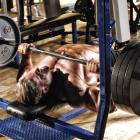 Normally, the most genetically gifted pro bodybuilders don’t have much of value in terms of muscle-building advice that we mere mortals can use. When you have only to think about lifting weights and your muscles grow larger, you probably never have to put much thought into your training. Occasionally, though, even the superstars have a bodypart that doesn’t respond the way the rest of their freakishly developed muscle groups do, and they need to figure out how to remedy that situation. Such was the case with four-time Mr. Olympia Jay Cutler, who noticed early in his bodybuilding career that his pecs did not grow at anywhere near the rate of his best bodyparts, like his shoulders and quads. You would never know that his chest was once, in his words, “my worst bodypart,” because he made it his mission to bring it up to match the rest of his upper body. Here’s how he did it.
Normally, the most genetically gifted pro bodybuilders don’t have much of value in terms of muscle-building advice that we mere mortals can use. When you have only to think about lifting weights and your muscles grow larger, you probably never have to put much thought into your training. Occasionally, though, even the superstars have a bodypart that doesn’t respond the way the rest of their freakishly developed muscle groups do, and they need to figure out how to remedy that situation. Such was the case with four-time Mr. Olympia Jay Cutler, who noticed early in his bodybuilding career that his pecs did not grow at anywhere near the rate of his best bodyparts, like his shoulders and quads. You would never know that his chest was once, in his words, “my worst bodypart,” because he made it his mission to bring it up to match the rest of his upper body. Here’s how he did it.
Proper body positioning. A major culprit in the lack of pectoral development in general is that many trainees have no idea how to make their pecs do the work in pressing movements. Instead, they press with mostly their front delts and triceps, with the chest hardly getting any stimulation. Jay experimented with various adjustments until he found the proper body position and then constantly reminded himself to maintain it during all chest exercises. He would say in his head, “Chest up, back arched.” That effectively took his delts and triceps out of the equation more and forced the pecs to do the work. Eventually, that form became second nature.
Using his own optimal range of motion. As much as we love to say that there is one true way of performing an exercise that is considered “proper form,” we should be wary of absolutes. Due to individual variances in structure, one man’s perfect form might be terribly ineffective for another. Cutler found that using a full range of motion on pressing movements, widely considered ideal, was taking the tension off his chest and shifting it toward his front delts and triceps at the full stretch and the full contraction points on each rep. Once he started stopping short of both and maintaining constant tension on his pecs as he pressed, he found that his chest was getting far more stimulation, as evidenced by the fact that it was more pumped during the workout and sorer for the next day or two.
Ditching the ego. How much ya bench? That’s a very pertinent question to ask a powerlifter, but it’s about as relevant to a bodybuilder as querying him about his favorite TV show. The weights we use are just tools, a means to an end. Lifting very heavy weights in your pressing movements is a great ego booster, but it’s only a good thing if it’s also giving you great growth in your pecs. As obsessed as so many guys are with how much weight they can handle, the only thing that matters in bodybuilding is the development of your muscles. Cutler decided early in his training career that he wouldn’t press weights that he couldn’t get at least eight reps with or couldn’t feel his chest working with. As enormous as he is—Jay walked around at a lean 290 at 5’9” for many years—he never cared about how strong he was, especially compared to other bodybuilders. The goal was to beat his rivals onstage, not in a bench press meet.
Abandoning the bench press once it became a risky proposition. Finally, although Jay feels that the flat-bench barbell press is an excellent mass builder and should be the foundation of all chest training for bodybuilders seeking to build a bigger chest, he also recognized a couple of years ago that the potential risks of performing this exercise were starting to outweigh the benefits. After coming close to tearing a pec, he dropped bench presses from his routine. His feeling was that once a bodybuilder reaches a certain level of size and strength, heavy benches put excessive forces on the shoulder joints as well as the tendons that connect the pectoral muscles to them. Instead, he switched to flat-bench dumbbell presses and Smith machine bench presses and never had a problem with near-injury to his chest or shoulders again.
—Ron Harris
Editor’s note: Ron Harris is the author of Real Bodybuilding—Muscle Truth From 25 Years in the Trenches, available at www.RonHarrisMuscle.com.




















You must be logged in to post a comment Login